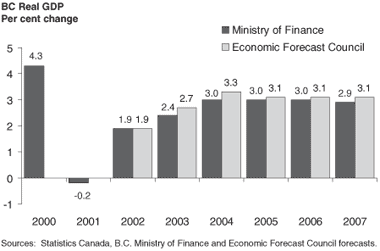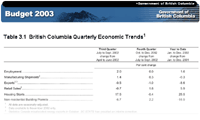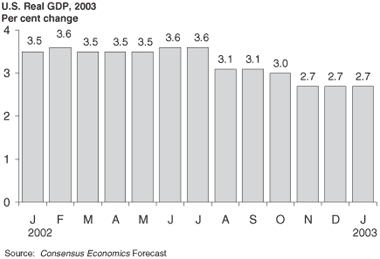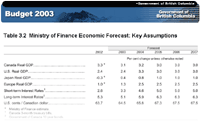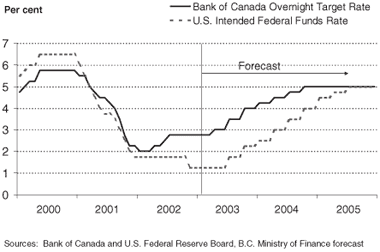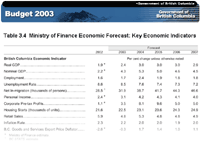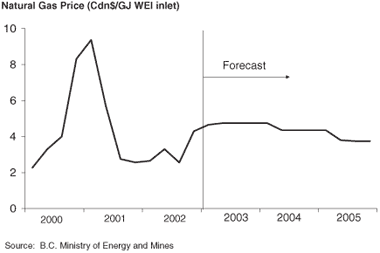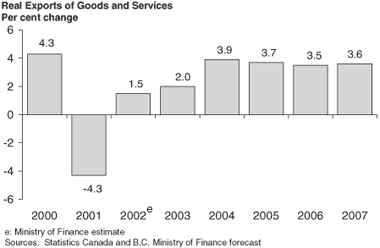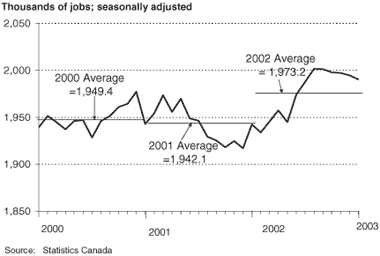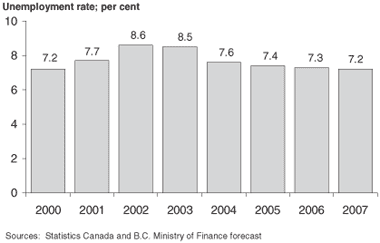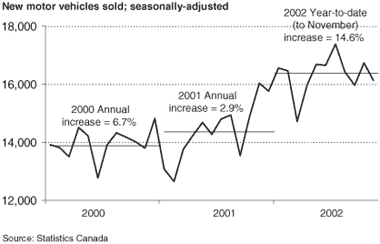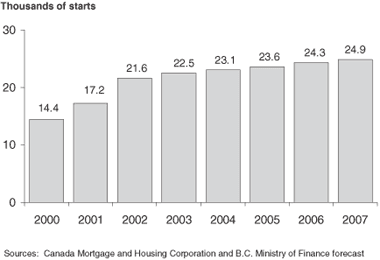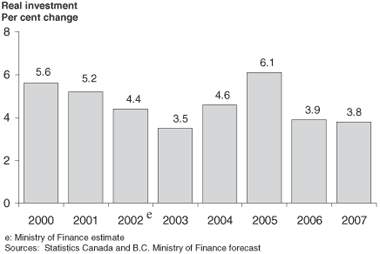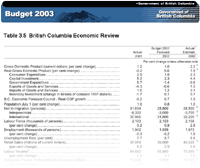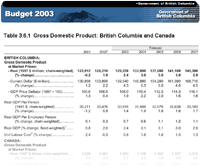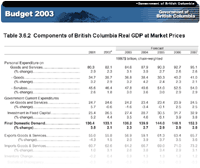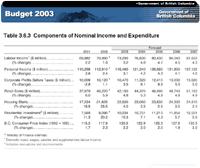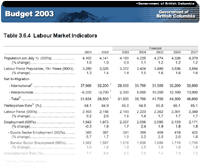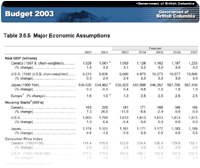 |
|
Overview1The British Columbia economy rebounded strongly in the first half of 2002, moderating later in the year in line with a hesitant U.S. recovery. The Ministry of Finance estimates that the B.C. economy grew 1.9 per cent in 2002, following a 0.2 per cent decline in 2001. B.C. real GDP is forecast to grow 2.4 per cent in 2003 and 3.0 per cent in 2004. This is slightly lower than the average of the independent Economic Forecast Council, a group of private sector economists who provide advice to the Minister of Finance on the provincial economic outlook. The Council forecasts growth in British Columbia of 2.7 per cent in 2003 and 3.3 per cent in 2004 (see Chart 3.1). The topic box at the end of Part Three reports on the December 2002 consultation with the Council. In the period 2005 through 2007, the British Columbia economy is expected to grow about 3.0 per cent per year in line with higher commodity prices and economic growth in the province's key trading partners. Investment in the province is forecast to increase due to improved business confidence and increased opportunities resulting from federal and provincial tax cuts, deregulation and investment in infrastructure. Chart 3.1 British Columbia economic outlook
Recent DevelopmentsWhile the B.C. economy bounced back strongly during the first six months of the year, the hesitant U.S. recovery and increasing geopolitical tensions began to affect the province's economy in the latter half of 2002. Key economic indicators in the final quarter continued the mixed performance experienced in the third quarter (see Table 3.1). Employment growth paused, following strong growth in the previous three quarters. Retail sales bounced back from a decline in the July to September period, posting a 1.6 per cent quarterly increase (based on data to November). Housing starts paused following strong growth in the July through September quarter, and closed the year with a 25.5 per cent gain. The value of non-residential building permits grew a modest 2.2 per cent after declining during much of the year. On the external side, manufacturing shipments were up slightly, while the value of exports were down, mostly as a result of lower lumber export prices.
The Outlook for the External EnvironmentDuring 2002, the North American economy expanded at a moderate pace, reflecting a hesitant U.S. recovery. A much stronger recovery in Canada was evidenced by growth in employment, housing construction and trade. Geopolitical uncertainties heated up in 2002 as tensions around the war on terrorism, the situation in the Middle East, the revelation of North Korea's nuclear program and the oil sector strike in Venezuela raised concerns for the global economy. The U.S. economy expanded 2.4 per cent in 2002, an improvement from the 0.3 per cent growth recorded in 2001 when the U.S. dipped into recession. Consumer spending was up strongly due to increased sales of consumer durables and a surge in automobile sales caused by dealer incentives and low interest rates. Housing starts rose 6.4 per cent to 1.7 million units, the highest level since 1986. However, behind the improvement in total output were signs of slowing business investment and manufacturing output. Industrial production declined 0.7 per cent in 2002. Spending on non-residential structures declined 17.0 per cent as a result of the significant excess capacity that has plagued the U.S. economy in recent years. As a result of the hesitant U.S. recovery and increasing geopolitical uncertainty, forecasters have gradually lowered their 2003 U.S. outlook. The latest Consensus Forecasts (published January 13, 2003) predicts growth of 2.7 per cent in 2003, down from the 3.6 per cent forecast in July 2002 (see Chart 3.2). Most forecasters expect the low interest rates that have been in place for the last year coupled with the federal administration's stimulus package to eventually lead the U.S. economy to more solid growth by 2004. The consensus is that growth will improve to 3.7 per cent in 2004. Chart 3.2 Evolution of the U.S. consensus forecast, 2003
The Ministry of Finance assumes U.S. growth will be a modest 2.4 per cent in 2003, the same growth recorded in 2002 and lower than the consensus. In 2004, the U.S. economy is assumed to expand 3.3 per cent, followed by a moderate 3.0 per cent per year over the medium term. This somewhat conservative outlook is imparted by concerns about the geopolitical situation, as well as low business investment growth. Consumer spending is expected to be moderate until the recovery generates stronger employment growth. Core inflation should continue to be muted given the lack of bottlenecks in key areas of the economy.
The Canadian economy outperformed the U.S. economy in 2002, growing an estimated 3.3 per cent. Unlike the U.S., growth in Canada was broadly based and accompanied by significant gains in employment. Canadian interest rates remained near historically low levels despite a modest increase in July. Consumer spending was strong with retail sales up 6.3 per cent in the first eleven months of 2002, compared to the same period in 2001. Purchases of larger consumer durables, like furniture and appliances, as well as new motor vehicles drove the year-to-date increase. The manufacturing sector in Canada benefited from lower production costs on goods sold into the U.S. market thanks to a weak Canadian dollar. The Ministry of Finance forecast assumes the Canadian economy will outperform the U.S. in 2003, with real GDP expanding 3.1 per cent. Growth is expected to be broad based with most sectors contributing to the increase in economic activity. However in 2004, Canadian economic growth is assumed to be slightly lower than the U.S. This is due to the return to solid growth south of the border rather than slower growth in Canada. Consumer price inflation is assumed to be slightly above the Bank of Canada's one to three per cent target range in the near term due to one-off price effects. Over the medium term, the Canadian economy is expected to expand 3.0 per cent per year, in line with growth of its major trading partner, the U.S. economy. The latest Consensus Forecasts predicted Canadian growth of 3.2 per cent in 2003 and 3.4 per cent in 2004. Overseas, economic conditions were stagnant in Japan. Japanese real GDP contracted by an estimated 0.3 per cent in 2002, following growth of just 0.3 per cent in 2001. High oil prices, resulting from the strike in Venezuela and rising tensions in the Middle East, have hurt the economy. The outlook for Japanese economic growth remains weak. Elsewhere, the European economy is confronting challenges including weakening domestic demand and, in Germany, a fragile banking system. The German economy grew just 0.2 per cent in 2002, the slowest growth in nine years. Robust growth in exports saved Europe's largest economy from slipping into a recession last year. Excluding exports, Germany's real GDP contracted 1.3 per cent. In 2003, Europe is expected to grow a modest 1.3 per cent. Growth is forecast to pick up to 2.5 per cent in 2004 through 2007. Financial MarketsInterest rates held steady for most of 2002. Before the 50 basis point reduction in the federal funds rate in November, this key U.S. interest rate had been unchanged since December 2001. In Canada, the Bank of Canada raised the overnight target rate by 75 basis points between April and July 2002 and then stayed on the sidelines for the remainder of the year. The relative lack of movement in U.S. interest rates reflected the weakness of the U.S. recovery. At the same time, Canada's economy was rebounding strongly and output was moving closer to full capacity. Rising geopolitical uncertainty and a lack of a solid global recovery helped ease some of the pressure to raise domestic interest rates. Chart 3.3 Interest rates are forecast to rise
Outlook: Monetary conditions are expected to change gradually during the forecast period as the U.S. recovery gathers momentum. Interest rates are forecast to rise to historical averages by 2005 (see Chart 3.3). The Canadian three-month treasury bill rate is forecast to average 3.3 per cent in 2003, rising to 5.0 per cent in 2005 through 2007. Ten-year Government of Canada bonds are forecast to average 5.1 per cent in 2003, rising to 6.3 per cent in 2005 through 2007. The value of the Canadian dollar averaged 63.7 cents US in 2002, down from 64.6 cents US in 2001. Signs of weakness in the global recovery and the related lack of demand for commodities contributed to the depreciation of the Canadian dollar. For 2003, the Canadian dollar is forecast to appreciate slightly, averaging 64.5 cents US, then rise gradually to 67.5 cents US in 2006. The British Columbia OutlookThe British Columbia economy grew an estimated 1.9 per cent in 2002. Growth was mainly due to increased domestic activity. Consumer spending, which accounts for about two-thirds of economic activity in the province, benefited from continued low interest rates, growth in employment and federal and provincial tax cuts. Investment in residential construction also increased as new home construction had its best year since 1997. However, the value of non-residential building permits declined due to a reduction in commercial, institutional and government construction. On the external side, real exports of goods and services posted modest growth, reflecting the hesitant U.S. recovery.
The British Columbia economic recovery, which began in earnest early in 2002 then faded as global uncertainties emerged, is expected to continue at a moderate pace during the foreseeable future. Growth in B.C. real GDP is forecast at a moderate 2.4 per cent in 2003. Given the risks and uncertainties in the external outlook and the ongoing effects of the softwood lumber dispute, the British Columbia economy is expected to post a gradual recovery with the pace of expansion increasing to around 3.0 per cent in the medium term. Table 3.4 presents the economic outlook for key indicators, while the tables at the back of Part Three provide further detail on the economic forecast. External Trade and Commodity MarketsDevelopments in external trade and commodity markets during 2002 reflected global economic conditions. Overall, commodity markets were flat, with some weakening in forest product prices as Canadian lumber producers contributed to oversupply in U.S. markets. The average price of British Columbia goods and services exports declined an estimated 2.6 per cent in 2002, due to lower prices for key commodities, including pulp, newsprint, copper, natural gas and lumber, although several of these prices have picked up in recent months.
Chart 3.4 Natural gas prices to remain high in 2003
In addition to lower commodity prices in 2002, the province's forest sector was required to pay a 27 per cent average tariff on softwood lumber exports to the U.S. after May 22, 2002. Lumber exports were higher than expected, as British Columbia mills ramped up lumber production as a way to reduce unit costs. Without prejudice to the outcome of negotiations, the forecast assumes a status quo situation in the forest sector. Outlook: Real exports of goods and services are expected to grow 2.0 per cent in 2003 and 3.9 per cent in 2004, as the U.S. recovery begins to gather momentum and as geopolitical uncertainties subside. Most commodity prices are forecast to increase gradually beginning in mid-2003. Natural gas prices have risen in recent months, and are expected to remain high in 2003. The average price of British Columbia goods and services exports is forecast to decline a slight 0.3 per cent in 2003, and then pick up to 1.7 per cent growth in 2004. Chart 3.5 Export trends reflect North American growth
The Labour Market Employment in British Columbia averaged 1,973,200 persons in 2002, up from 1,942,100 persons in 2001, an average gain of 31,100 jobs (see Chart 3.6). Employment climbed from December 2001 through September 2002, adding 84,400 jobs during that period, almost two-thirds of which were full-time jobs. Employment growth paused in the fourth quarter of 2002 mainly due to a small decline in construction, public administration and community and personal services. In addition, an increase in part-time employment was offset by a decline in full-time employment during the October to December quarter. The unemployment rate averaged 8.6 per cent in 2002, up from 7.7 per cent in 2001, as growth in the labour force outweighed the annual employment gains. Chart 3.6 Employment increased sharply in 2002
Chart 3.7 Unemployment rate forecast to decline
Outlook: Employment is forecast to increase 1.7 per cent, or 34,000 jobs for 2003, rising to 2.4 per cent (or a gain of 49,000 jobs) for 2004. As economic growth picks up, it is expected that a larger share of the job gains will be in full-time employment. The unemployment rate is expected to average 8.5 per cent in 2003, and then decline to 7.6 per cent in 2004. Domestic DemandMuch of the strength in the British Columbia economy during 2002 came from the domestic side of the economy. Housing starts and retail sales, two key indicators of consumer spending, recorded solid annual growth with annual housing starts up 25.5 per cent and the value of retail sales increasing an estimated 5.9 per cent last year. Employment gains, low interest rates, as well as federal and provincial tax cuts supported the consumer sector last year. At the same time, reduced business investment, as well as reduced spending by the combined three levels of government, restricted economic growth. In 2003 and beyond, the domestic side of the economy is expected to post continued growth as strong consumer spending continues and business investment picks up. Consumer Spending and HousingThe value of retail sales rose 5.9 per cent in the first eleven months of 2002, compared to the same period in 2001. The increase was mainly due to the higher value of large consumer durables including new motor vehicles, furniture and appliances. The removal of the luxury tax on mid-range vehicles combined with deep discounting by auto dealers early in the year, as well as a booming housing sector, helped fuel demand for these goods and related services. The volume of new motor vehicle sales was up 14.6 per cent in the first eleven months of 2002, compared to the same period in 2001, the second highest increase in Canada and well above the national average of 9.0 per cent (see Chart 3.8). Chart 3.8 New motor vehicle sales surged in 2002
The residential construction sector was a source of strength in the British Columbia economy in 2002. Low mortgage interest rates and employment gains helped increase the demand for housing. Major residential markets in the province recorded rising prices as demand from homes outpaced available supply. As a result, housing starts totalled 21,625 units in 2002, a 25.5 per cent increase from 2001. Outlook: Consumer demand for goods and services will be supported by employment gains and continued low interest rates during the next few years. With pent-up demand fuelling housing construction, related consumer purchases should continue to expand. Housing starts are forecast to total 22,500 units in 2003 and 23,060 units in 2004. Over the 2005 to 2007 period, growth in housing starts is expected to average 2.6 per cent per year to reflect growth in the province's population and the aging of the existing housing stock. After adjusting for inflation, consumer spending is forecast to grow 3.1 per cent in 2003 and 3.9 per cent in 2004 and then average 2.6 per cent in 2005 through 2007. Chart 3.9 Residential construction growth to continue
Business and GovernmentOne of the key factors behind the lack of stamina in the U.S. economic recovery in 2002 and early 2003 has been low business investment. This has been a lesser problem in Canada because there was less excess production capacity than in the U.S. In British Columbia, growth in corporate profits was slightly better in 2002 than in 2001, but remained under downward pressure due to the continued impact of the softwood lumber dispute in the forest sector. Business investment in machinery and equipment, non-residential structures and inventories, accounts for about 10 per cent of economic activity. The Ministry of Finance estimates that total investment (business, government and residential) increased 4.4 per cent in 2002. Spending by the three levels of government (local, provincial and federal) accounts for about 20 per cent of economic activity in British Columbia. In 2002, total government spending is estimated to have declined 0.6 per cent in inflation adjusted terms. Outlook: Total investment in British Columbia is forecast to grow 3.5 per cent in 2003 and then average around 4.5 per cent per year in the 2004 to 2007 period. Most of the near-term growth is in residential investment and stems from a very active housing market, fuelled by low mortgage rates and federal and provincial tax cuts. In the medium term, the improving outlook is due to increased business investment in machinery and equipment and non-residential structures, by the oil and gas, high-tech and other manufacturing sectors such as electronic, communications, aircraft parts and biotech industries. The service sector is also forecast to grow in line with increased demand, lower prices for investment goods and lower corporate income tax rates. Chart 3.10 Investment to increase
In inflation-adjusted terms, spending by the three levels of government is expected to decline a combined 1.6 per cent in 2003 and 3.4 per cent in 2004. The decline reflects the lower provincial government spending necessary to balance the budget beginning in 2004/05. Over the 2005 through 2007 period, inflation-adjusted government spending is forecast to average 1.6 per cent growth per year as the provincial government begins to achieve surpluses. The forecast reflects provincial government measures announced in Budget 2003, as well as planned provincial, federal and public-private partnership and transportation projects. InflationConsumer price inflation was moderate for the first half of 2002 as prices rose at a gradual rate. However, by the fall of 2002, the year-over-year change in the consumer price index had gone above the Bank of Canada's one to three per cent target range. In January 2002, the national rate of inflation was 1.3 per cent, but by December it had climbed to 3.9 per cent. The increase in the rate of inflation was a result of falling prices in the wake of the events of September 11, 2001 as well as various one-off price increases in 2002 including higher auto insurance premiums across the country. In British Columbia, inflation climbed to 3.5 per cent in December from 0.8 per cent in January 2002. Outlook: Consumer price inflation is expected to moderate in early 2003 as the influence of price discounting in the last quarter of 2001 diminishes. As a result, inflation is forecast at 2.2 per cent in 2003 and 2.0 per cent in 2004. Over the medium term, inflation is expected to average 2.0 per cent. This is in line with the midpoint of the Bank of Canada's stated inflation target range of one to three per cent. Risks to the OutlookThe economic forecast is based on a set of assumptions regarding growth in external trading partners, interest rates and the exchange rate. As with all forecasts, there are risks that could alter the outlook to produce stronger or weaker-than-expected growth in British Columbia. The global outlook has deteriorated somewhat in the past six months as geopolitical uncertainties have increased. In light of these developments, the Ministry's external growth assumptions are lower than the latest available Consensus Forecasts. The most significant risk to the British Columbia outlook remains the strength of the U.S. recovery. The potential impacts on the British Columbia economy of the ratified Kyoto agreement on climate change are not well established. However, any such impacts are not expected until later in the forecast period. Economic growth in British Columbia could be lower than forecast if:
On the other hand, implementation of the provincial government's integrated transportation plan will bring forward economic development opportunities and partnering opportunities for investment in the highway system, public transit and community airports. The Vancouver/Whistler bid for the 2010 Olympic Winter Games also poses opportunities related to investment in infrastructure. Economic growth in British Columbia could be stronger than forecast if:
|
|||||||||||||||||||||||||||||||||||||||||||||||||||||||||||||||||||||||||||||||||||||||||||||||||||||||||||||||||||
|
||||||||||||||||||||||||||||||||||||||||||||||||||||||||||||||||||||||||||||||||||||||||||||||||||||||||||||||||||||
